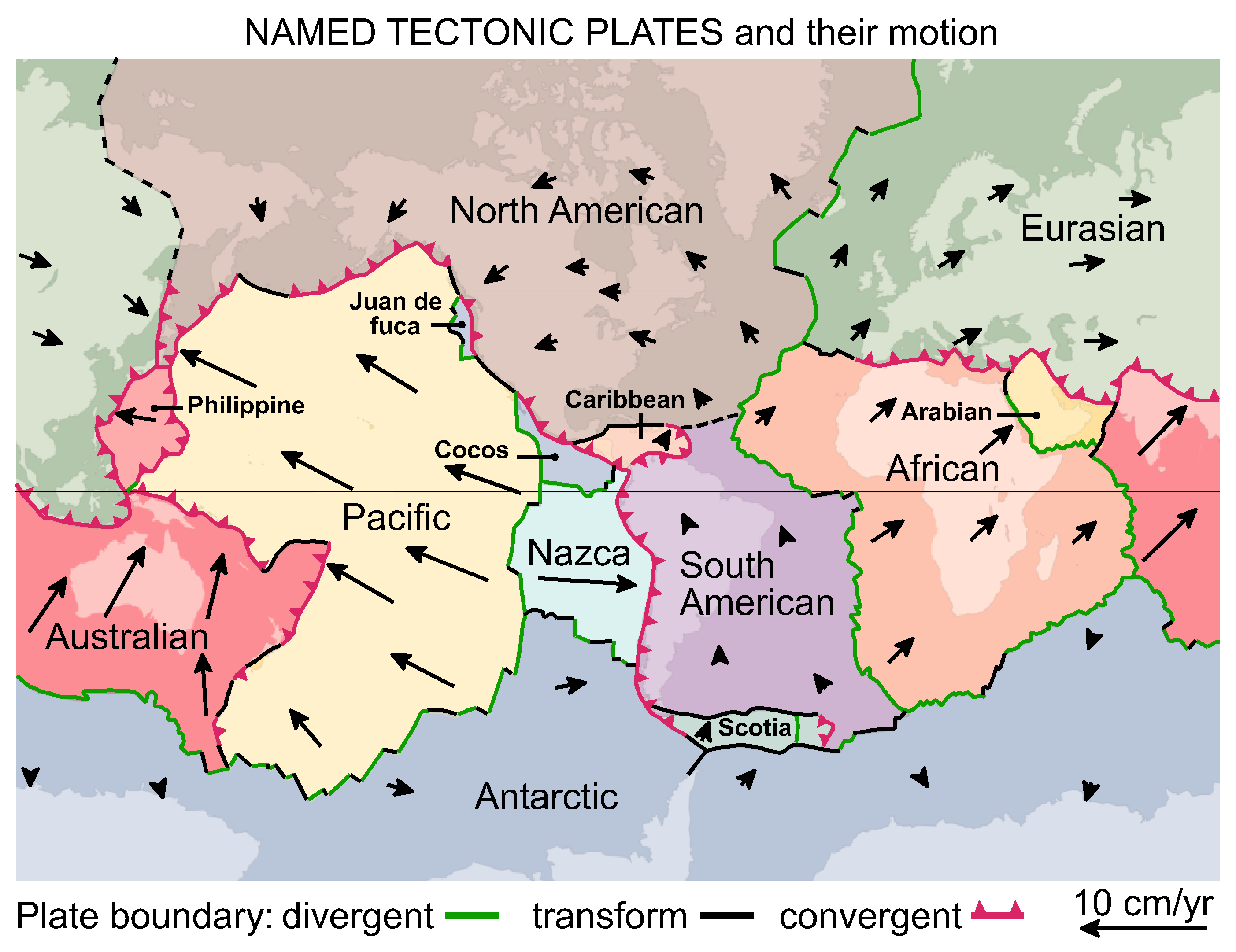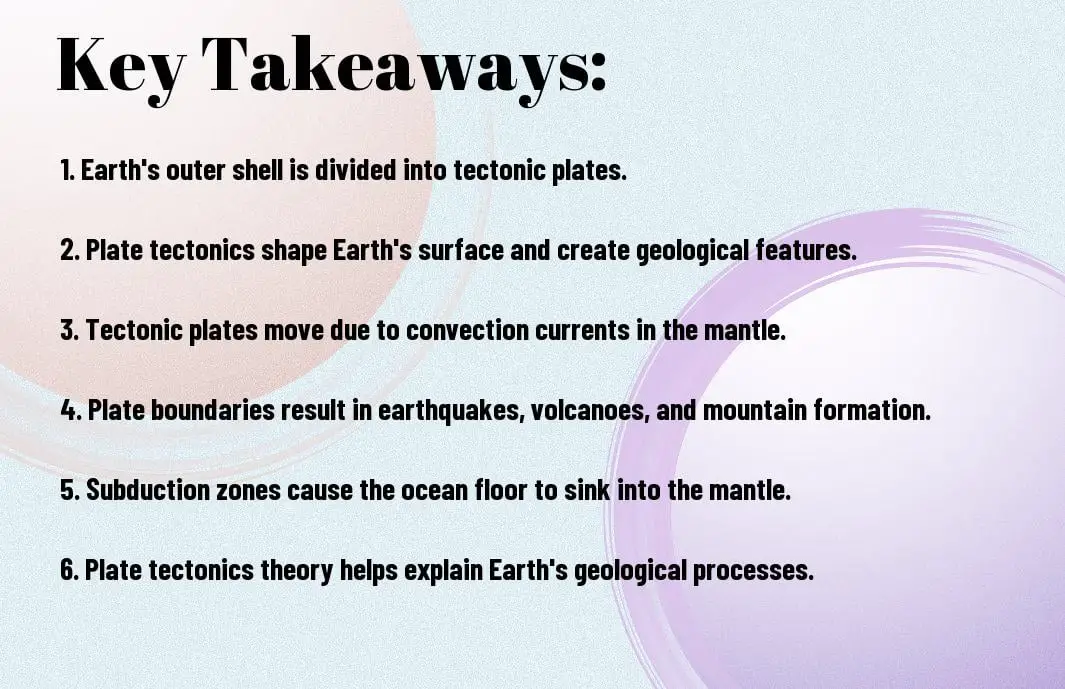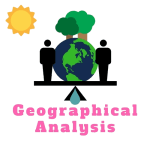Plate tectonics is a fundamental geological process that plays a crucial role in shaping the Earth’s surface and influencing natural disasters. Understanding the dynamics of plate tectonics is essential for comprehending the distribution of volcanoes, earthquakes, and mountain ranges. In this blog post, we will delve into the scientific principles behind plate tectonics, exploring the movement of Earth’s lithosphere and the forces driving tectonic activity. By gaining insight into this complex process, we can gain a deeper understanding of the dynamic geography of our planet and the potential hazards it presents.
Key Takeaways:
- Plate Tectonics: Plate tectonics is the scientific theory that explains the movement of the Earth’s lithosphere, which is composed of several large and small tectonic plates that fit together like pieces of a jigsaw puzzle.
- Earth’s Dynamic Geography: The study of plate tectonics helps us understand how the Earth’s surface is constantly changing, with processes such as volcanic eruptions, earthquakes, and mountain building shaping the planet’s dynamic geography.
- Impact on Life: Plate tectonics has had a significant impact on the evolution of life on Earth, influencing the distribution of species, the formation of natural resources, and the creation of diverse landscapes and ecosystems.
Historical Background
Some of the most fundamental concepts in the science of plate tectonics have been developed through the careful observation and study of the Earth’s geological history. By understanding the historical background of this field, we can gain a deeper appreciation for the complexity and dynamics of our planet’s geography.
From Continental Drift to Tectonic Theory
The historical journey towards the modern understanding of plate tectonics began with the controversial theory of continental drift proposed by Alfred Wegener in the early 20th century. This daring hypothesis suggested that the continents were once connected as a single landmass, with subsequent movement causing them to drift apart. The idea was met with skepticism at first, but over time, mounting evidence from geological, paleontological, and geophysical studies supported Wegener’s concept, eventually laying the groundwork for the development of the tectonic theory.
The true breakthrough in the history of plate tectonics came with the synthesis of data from various fields by scientists such as Harry Hess and Robert Dietz in the mid-20th century. They proposed the concept of seafloor spreading, which provided compelling evidence for the movement of the Earth’s crust and the existence of tectonic plates. This revolutionary idea not only explained the mechanism behind continental drift but also helped to unlock the mysteries of volcanic activity, seismic events, and the formation of mountain ranges.
Key Scientists and Discoveries
Background: As the field of plate tectonics continued to evolve, numerous key scientists and their groundbreaking discoveries have played crucial roles in shaping our understanding of the Earth’s dynamic geography. From the pioneering work of Arthur Holmes and his insights into mantle convection to the instrumental research of J. Tuzo Wilson on transform faults and plate boundaries, these visionaries and their contributions have been instrumental in advancing the tectonic theory.
With their collaborative efforts and persistent pursuit of knowledge, these scientists have not only expanded our understanding of plate tectonics but also provided invaluable frameworks for predicting and mitigating natural hazards such as earthquakes and volcanic eruptions. Their legacies continue to inspire future generations of geoscientists to unravel the mysteries of the Earth’s dynamic processes and strive for a safer and more sustainable coexistence with our ever-changing planet.
Fundamentals of Plate Tectonics
Now, let’s dive into the fundamentals of plate tectonics, the scientific theory that explains the movement of the Earth’s lithosphere.
Structure of the Earth
Fundamentally, the Earth consists of several layers, including the inner core, outer core, mantle, and crust. The lithosphere, which is composed of the crust and uppermost part of the mantle, is broken into tectonic plates that float on the semi-fluid asthenosphere beneath them. It is this structure that allows for the movement of the tectonic plates.
Types of Tectonic Plates and Boundaries
With tectonic plates come various types of boundaries where they interact. These include divergent boundaries, where plates move away from each other; convergent boundaries, where plates move towards one another; and transform boundaries, where plates slide past each other horizontally. Additionally, there are several types of tectonic plates, including continental plates, oceanic plates, and mixed plates. Importantly, the interaction of these plates at their boundaries is what causes seismic activity and geological phenomena such as earthquakes and volcanoes.
- Continental Plates
- Oceanic Plates
- Mixed Plates
- Divergent Boundaries
- Convergent Boundaries
Plates move due to the heat-driven convection currents in the Earth’s mantle. This movement not only shapes the Earth’s geography, but it also influences the distribution of continents and the occurrence of geological events.
Mechanisms of Plate Movement
For the plates to move, there are several mechanisms at play. Ridge push, where the force of gravity pushes plates away from the oceanic ridges, and slab pull, where the weight of the subducting plate pulls the rest of the plate down, are two of the fundamental forces driving plate movement.
Plus, the convection currents in the mantle also play a significant role in the movement of tectonic plates, providing the necessary force to drive plate tectonics.
Phenomena Explained by Plate Tectonics
Unlike traditional geological theories that struggled to explain various natural phenomena, the theory of plate tectonics provides a comprehensive understanding of several earth processes. From earthquakes and volcanic activity to mountain building and ocean trench formation, plate tectonics offers a unifying explanation for the dynamic nature of our planet.
Earthquakes and Volcanic Activity
Any discussion of plate tectonics would be incomplete without considering its role in generating earthquakes and volcanic activity. The movement of tectonic plates along plate boundaries leads to the build-up of stress, causing rocks to deform and ultimately release energy in the form of earthquakes. Similarly, the movement of magma beneath the earth’s surface at plate boundaries gives rise to volcanic activity, shaping the earth’s surface and releasing gases and ash into the atmosphere.
Mountain Building and Ocean Trench Formation
Earthquakes occurring along plate boundaries are vital in the formation of mountain ranges and ocean trenches. For instance, the collision of two continental plates can lead to the uplift of land, resulting in the formation of majestic mountain ranges such as the Himalayas. On the other hand, the subduction of an oceanic plate beneath a continental plate can create deep ocean trenches, such as the Mariana Trench, revealing the immense power and impact of plate tectonics on the earth’s topography.
The Role in Climate and Evolution
Building on the understanding of plate tectonics, scientists have recognized its significant role in shaping the earth’s climate and influencing evolutionary patterns. The movement of tectonic plates affects the distribution of land and sea, altering ocean currents and creating diverse habitats for different species to evolve. Additionally, the release of carbon dioxide and other gases from volcanic activity contributes to the regulation of the earth’s climate over geological timescales.
To understand the complex interplay between plate tectonics, climate, and evolution, we must consider the long-term effects of mountain formation on rainfall patterns, the creation of new environments for species to adapt, and the potential for mass extinctions when tectonic activity disrupts the earth’s delicate balance.
Modern Observations and Technologies
After the initial development of the theory of plate tectonics, modern observations and technologies have been instrumental in furthering our understanding of Earth’s dynamic geography. The advent of advanced tools and techniques has allowed scientists to make groundbreaking discoveries and measurements that have revolutionized our comprehension of plate tectonics. One such resource is the video lecture The Plate Tectonics Revolution: Crash Course Geography, which offers a comprehensive overview of the subject.
Satellite Geodesy and Plate Motion Measurement
Observations using satellite geodesy have played a crucial role in measuring the motion of tectonic plates. By utilizing satellite-based technologies, scientists can accurately track the movement of Earth’s crust, allowing us to understand the processes driving plate tectonics. These measurements have provided valuable insights into the behavior of tectonic plates and have helped us comprehend the forces shaping the Earth’s surface.
Computational Modeling in Tectonics
Geodesy, in conjunction with computational modeling, has allowed scientists to simulate the behavior of tectonic plates. Using powerful computers and advanced software, researchers can create virtual models to study the complex interactions between different plates and their impact on geological phenomena. The integration of computational modeling in tectonics has significantly enhanced our ability to predict seismic activity and understand the evolution of Earth’s topography.
The utilization of modern observations and technologies, such as satellite geodesy and computational modeling, has advanced our knowledge of plate tectonics. The integration of these tools has allowed scientists to make groundbreaking discoveries and gain unprecedented insights into the dynamic processes shaping the Earth’s surface.
The Science Behind Plate Tectonics – Understanding Earth’s Dynamic Geography
Hence, it is clear from the evidence presented that plate tectonics is a fundamental concept that helps us understand the dynamic nature of Earth’s geography. By studying the movement of the Earth’s lithosphere, scientists have been able to better comprehend the formation of mountain ranges, earthquakes, and volcanic activity. This understanding has not only provided valuable insights into the Earth’s past but also helps us predict and prepare for natural disasters in the future. Plate tectonics is a key component in the field of geology and continues to shape our understanding of the Earth’s ever-changing landscape.
FAQ
Q: What is plate tectonics?
A: Plate tectonics is the scientific theory that Earth’s outer shell is divided into several large, rigid plates that move and interact in various ways, causing earthquakes, volcanic activity, mountain-building, and other geologic phenomena.
Q: How does plate tectonics work?
A: The Earth’s lithosphere, which is made up of the crust and the uppermost part of the mantle, is broken into pieces called tectonic plates. These plates move and interact at their boundaries, where they can collide, move apart, or slide past one another. This movement is driven by the heat and convection currents in the Earth’s mantle.
Q: What is the significance of plate tectonics?
A: Plate tectonics plays a crucial role in shaping the Earth’s dynamic geography. It is responsible for the formation of mountain ranges, the distribution of volcanoes and earthquakes, the creation of oceans and continents, and the movement of Earth’s landmasses over geological time. Understanding plate tectonics is essential for understanding the Earth’s past, present, and future geologic processes and landscapes.










